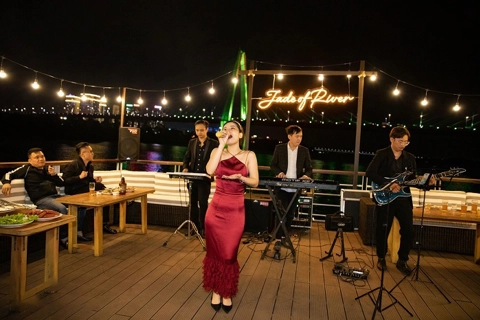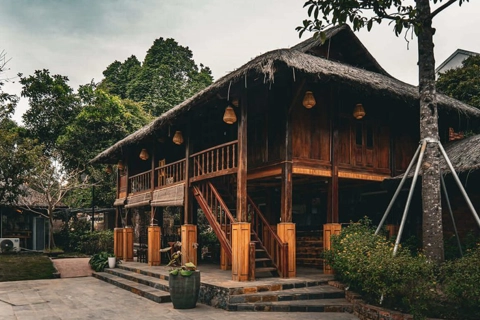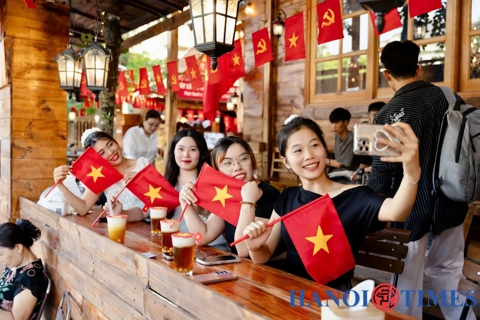Travel
Hang Dao street – the “Silk street”
Dec 25, 2020 / 11:02 AM
Hang Dao street originally belonged to Thai Cuc ward under the Le dynasty and then to Dong Lac and Dai Loi wards, Tien Tuc circumscription of Tho Xuong district.
Hang Dao street has borne this name since its coming into being, with a short period under the French colonial time when it was called Rue de la Soie (Silk Street). After 1945, it was re-named Hang Dao and this name has been kept until now. In the early 15th century, Nguyen Trai wrote the street name in the book titled ”National Geography”. "Hang Dao guild does dying work". This means that this street was the location of the silk dyer guild and specialized in red, pink, peach blossom dyes. In the 17th century, this street craftsmen widened the scope of dyeing to silk bleaching.
Hang Dao street also houses other worshipping architectures including Dong Lac shrine at No. 31; Dong Lac communal house at No. 38; Dai Loi temple also called Bach Bo temple at No. 47; Dai Loi communal house at the end of the street and due to road expansion, it was finally moved to No. 50 Gia Ngu street and Hoa Loc communal house at No. 90A.
In the French colonial time, Hang Dao Street was a center for silk product trading. Shops on both sides of the street sold a variety of silk items such as chiffon, satin, silk, fine silk, gauze, brocade, crepe, among others. On the first and sixth days of the lunar month, silk fairs named Hang To (silk guild) market were organized. At that time, some shops were selling clothes in Hang Dao Street but this item was sold predominantly at Hang Vai street nearby.
In the early 20th century, some Indian textile merchants opened shops for trading silk and wool products imported from the West. Also in this period, some grocery stores, gold and silver shops, hat making shops were established, but the main products offered at Hang Dao Street were still silk items.
For the revolutionary cause, Hang Dao street is also home to remarkable relics including the house at No. 10 which was Dong Kinh Nghia Thuc school from March to December of 1907 founded by scholar Luong Van Can who was from Nhi Khe village of Thuong Tin district and his associates. Renown anti-French revolutionary fighter Phan Chu Trinh lived here a short period of time and pronounced various revolutionary speeches. Another branch of the school was located the house at No.63 of this street which was also a large house with many compartments and the back door leading to the yard of Dai Loi communal house and connecting to Gia Ngu street. The influence of Dong Kinh Nghia Thuc rapidly widespread. Many places in the suburbs of Hanoi came here looking for textbooks and opened local classes as the reproduction of the Dong Kinh Nghia Thuc school model in Hang Dao street.
On the capital's Liberation Day (October 10, 1954), a detachment of the Vietnamese army went on a parade from Gia Lam outlying district to Hanoi downtown via Long Bien bridge, crossing Hang Dao street and was warmly cheered by the people who waved national flags and flowers in hand.
Currently, every weekend night, Hang Dao Street becomes a part of the Old Quarter night market, an attractive tourist destination of Hanoi capital.
 Hang Dao street – the “Silk street” |
In the French colonial time, Hang Dao Street was a center for silk product trading. Shops on both sides of the street sold a variety of silk items such as chiffon, satin, silk, fine silk, gauze, brocade, crepe, among others. On the first and sixth days of the lunar month, silk fairs named Hang To (silk guild) market were organized. At that time, some shops were selling clothes in Hang Dao Street but this item was sold predominantly at Hang Vai street nearby.
In the early 20th century, some Indian textile merchants opened shops for trading silk and wool products imported from the West. Also in this period, some grocery stores, gold and silver shops, hat making shops were established, but the main products offered at Hang Dao Street were still silk items.
For the revolutionary cause, Hang Dao street is also home to remarkable relics including the house at No. 10 which was Dong Kinh Nghia Thuc school from March to December of 1907 founded by scholar Luong Van Can who was from Nhi Khe village of Thuong Tin district and his associates. Renown anti-French revolutionary fighter Phan Chu Trinh lived here a short period of time and pronounced various revolutionary speeches. Another branch of the school was located the house at No.63 of this street which was also a large house with many compartments and the back door leading to the yard of Dai Loi communal house and connecting to Gia Ngu street. The influence of Dong Kinh Nghia Thuc rapidly widespread. Many places in the suburbs of Hanoi came here looking for textbooks and opened local classes as the reproduction of the Dong Kinh Nghia Thuc school model in Hang Dao street.
On the capital's Liberation Day (October 10, 1954), a detachment of the Vietnamese army went on a parade from Gia Lam outlying district to Hanoi downtown via Long Bien bridge, crossing Hang Dao street and was warmly cheered by the people who waved national flags and flowers in hand.
Currently, every weekend night, Hang Dao Street becomes a part of the Old Quarter night market, an attractive tourist destination of Hanoi capital.








